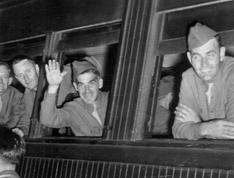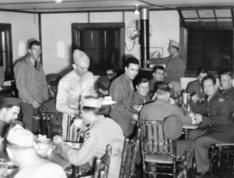The greatest Tri-state story of World War II, I believe, was the Evansville Red Cross Canteen. The 'Canteen' was located at the intersection of Ohio Street and Fulton Avenue, next door to the L & N Railroad Depot.
This small wood frame building served 1,612,000 service men and women. The Canteen operated only 3' years, averaging about 1,280 meals per day. The amazing fact is that no money was collected from any serviceman. All costs were provided for by the area citizens and the American Red Cross. All Canteen workers were volunteers, they numbered in the hundreds and for many this was their full time job.
In June 1942 the land was loaned by Southern Indiana Gas & Electric Co. The building was built by the Evansville Courier and the Evansville Press. The 20 by 35 foot building was completed in two weeks and placed in service on June 14, 1942.
Here are a few facts to clarify the situation; the usual mode of transportation was by railroad. America had about 11,000,000 men and women under arms. An inductee would ride to training base by rail; go home for leave by rail. Then perhaps to a special training camp, home again and then to a permanent duty station, all via the railroads.
The usual military train did not have a diner car. Sometime, when the train had many civilian passengers, a dining car would be attached. The boys, however, often did not have money to pay for food.
Some stories were distressing. One young man, Pvt. Taylor, said he had been standing on a train for 48 hours and often the troops said that they had not eaten for a day. It appears that the army and navy put the men on a train and provided water and toilets and nothing else. There may have been no dining provisions for them along the tracks. Some canteens charged for food. Remember, the main thing was to win the war. Everything else was in second place.
At any one time, there would have been many thousands of troops in the rail system. Evansville averaged 1,500 men and women per day during 1943 when more than 500,000 persons stopped for a meal, a drink and a chance to stretch their legs.
The Canteen received a constant flow of food, service and money contributions from a radius of about 50 miles around Evansville. The towns in Illinois, Kentucky and Indiana took the Canteen on as their responsibility; they kept it very well supplied with what they could offer.
The Evansville Courier gave a daily summary of goods and supplies that were donated. The gifts may have been a 4-H club prize beef, an entire crop, a live animal (prepared by an area packing house), canned goods, fresh produce, pies, cakes, tobacco products, coal for winter heat, cash, postage etc. One family donated 1,000 post cards for the 'boys'. Contributions would come from a small town, church groups, neighborhoods, a street, a city block, a store or a war plant.
While the flow of goods was endless, one must wonder how the canteen staff could continually deal with goods of such variance and quantity. Often, the donations may have included, for instance, a jar of canned pickles, several dozen donuts, a bushel of unshelled beans, a ham or some chickens.
Keep in mind that the building was not as large as a modern mobile home and it had little storage space and a tiny food preparation area.
Sugar was truly a big deal during the war as it was closely rationed. My late mother in law, Lucy Salyer, would bake a cake when she had a new supply of sugar. Lucy would put the cake and her toddler in a wagon, take her other two children in tow and
walk to the Canteen. She would leave her cake and anything else she had prepared or collected and walk the 14 blocks from home on West Maryland Street.
Many women, employed in area war plants, would contribute their sugar supply to other women who stayed home and could bake desserts for the Canteen.
A small child first brought her birthday cake to the Canteen 'so the soldier boys could have some cake'. She set an example that would be followed by many children.
Perhaps the most moving story was the several hundred mothers who would bring a birthday cake, complete with birthday message and trimmings to the Canteen. The cake was offered to the boys in tribute to her young son in service somewhere in the states or overseas.
One night the women staffers were treated by 30 black sailors from the Great Lakes Naval Training Station. The young men sang 'Anchors Aweigh' in appreciation for dinner. Often the Canteen had volunteer entertainment for the troops.
The canteen women served as mothers or doctors to those in need, menders to those with rips and lost buttons.
Perhaps the 2,100 soldiers having supper in a two hour time period was a record. Some days as many as 3,500 service men were accommodated. In 1943 5,000 Christmas packages were given to soldiers at the Camp Breckinridge hospital.
At times, the service men were sleeping or could not leave the train, so the volunteers would always take food and drink to the train. Sixty-five wounded troops on a hospital train were served sandwiches, ice cream and cigarettes by the Red Cross women.
The Red Cross had a multi-purpose mobile unit that collected large contributions, delivered food and drink to service men groups that may have had special problems or sick travelers that needed emergency aid at a hospital or physician. The Red Cross had a 'mobile canteen' van that would go where there were large numbers of troops.
In 1944 a small building was built between airplane hangers to serve as the Red Cross Airport Canteen for the many airmen that flew into and out of the busy Evansville Airport. They served around 100 meals per day.
Praise and tributes were shared on many allied ships and bases by boys that were served while passing through Evansville. Fred Redman, a radio-gunner on a B-24 bomber made a special trip to Evansville to tell the Canteen volunteers how much he and the boys enjoyed the good food and fine treatment they had received at the canteen.
"When we talked about our hometowns nobody had ever heard of Epworth, Illinois," Redman said, "but when I would say Epworth was 38 miles from Evansville, the guys started talking about the Evansville canteen. You would have been very pleased if you could have heard only a few of their stories about this canteen."
Redman told the women that he had been stationed in England, Ireland, Scotland, Greenland, Iceland, France and Germany and in all those countries the Evansville canteen was well known by many of his buddies.
The Canteen closed January 1, 1946. The Evansville Courier suggested that the Canteen would be missed more by the volunteer workers than the service men who felt the warmth of their hospitality.
Special thanks were given by Camp Breckinridge for the Canteens service to the soldier trainees that had been stationed at the camp.
Miss Miskel Wolfinger, Canteen chairwoman, locked the Canteen door, this was the only time the key had ever been used and it was the last as well as the first. She handed the key to Walter Dreier, Red Cross Chapter chairman.
The only remaining evidence of the Canteen today is the collection of thank you cards and letters in the Evansville Red Cross office.


